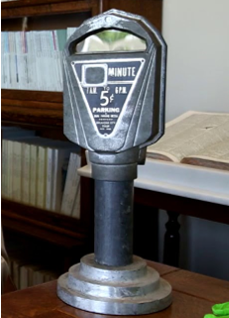Continuing from the last “What About Parking” we discussed when and why Shreveport Decided To install parking meters. Let’s continue the discussion.
Throughout the article (“Ask Council to Study Park-O-Meters”), Mr. Richardson provided a lot of information about his visit to Oklahoma and his findings. He talks about the various stakeholders that he encountered and their affinity for Oklahoma’s parking meter system. How merchants were in accord with the meter’s usefulness. How the police said that the meters aided them with “traffic handling”, and how parking lot owners all reported a big increase in business due to the meters. He said “Ladies particularly like(ed) the parking meters” because they could easily find a place to park and make a “quick haul” at a nearby store and for those he asked whether they minded spending a nickel, the universal answer was no, because the space is theirs for an hour and they will have ample space to avoid dented fenders and can easily maneuver out of the space.

Mr. Richard also talked about the popularity of the meters and how “committee after committee” had been “appointed to Oklahoma to study and find a possible means to solve the “parking problem”. Newspapers throughout the US had written editorials favoring installation and the operation of the meters. He said that “delegations arrive almost daily from other points to investigate the possibilities”, and that publicity of the meters had been “nationwide”! According to Richard, Dallas, TX was using 500 meters and planned to install 1500 more. Houston, TX was expected to have the meters soon and New York, NY was expecting a shipment of 10,000. The article ends with verbiage from the Shreveport Chamber of Commerce’s resolution urging the City Council to further investigate the possibility of installing Park-O-Meters in the downtown business district.

The article is interesting because the information allows us to compare parking downtown in 1935, to parking downtown in 2024. The article gives a physical description of the Park-O-Meter and how it works. It explains how a green flag is raised once you insert your nickel and turn a handle. That the flag is enclosed in a glass case, and when raised, it shows that the space is reserved for a “given period of time”. The payment starts a clock, and when the time expired the green flag drops. It further explained that any car that is in a space without a flag up is over-parked and the police can “tag” it. Its surprising how similar some of our parking meters are to the original parking meter from 90 years ago. We still use some POM (Park-O-Meter) meters today. They also use a green flag to show that the space is paid/reserved. This type of meter is no longer manufactured by POM and will eventually become extinct as they stop operating and/or are replaced with newer technology.

Fun Facts:
- In 1934, the meter rate was $.05/hr, as compared to $.50/hr today (90 years later).
- An expired meter ticket was $1.00 then, as apposed to $10.00 now.
- The price to purchase a parking meter was $59.00 then, while today’s smart meters are priced in the $500 range.
- POM Inc. (Park-O-Meter) is now based in Arkansas. We purchase accessories (batteries, locks, keys) for our older POM meters each year.
- Parking meters have become a way of life in cities all over the world.
The Global Parking Services Market was estimated to be valued at $114.8 billion in 2023. The US accounted for just under 1/3 of the market (31%).


